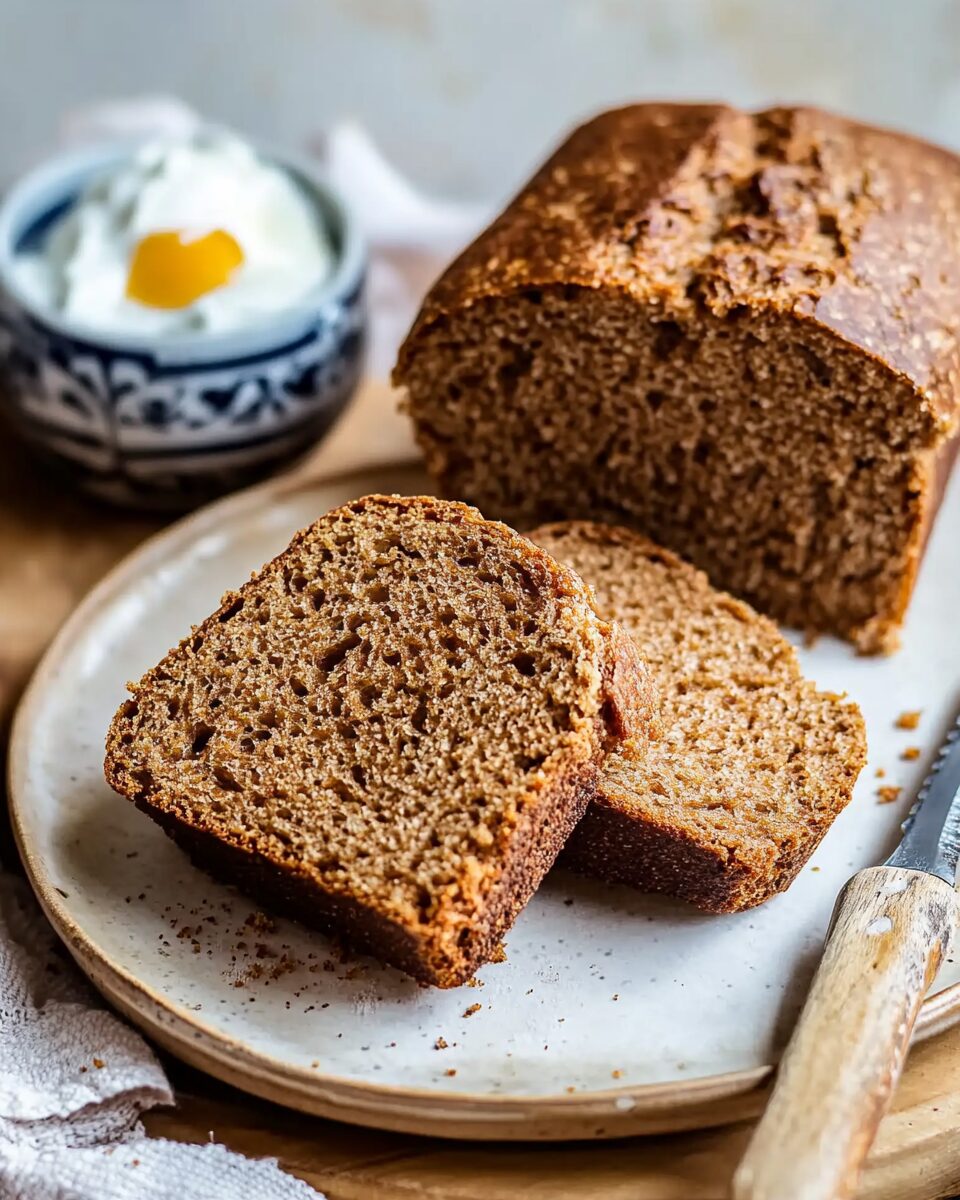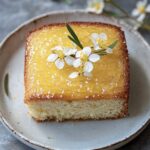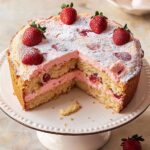This Irish Brown Bread is everything a hearty loaf should be—dense, nutty, and slightly sweet with deep flavors from molasses and whole wheat. Its rustic, coarse texture and chewy crust make it perfect for slicing and slathering with Irish butter, serving with a traditional breakfast, or pairing with bold cheeses and smoked salmon.
Using stone-ground whole wheat flour and wheat bran, this recipe honors the authentic Irish baking tradition. Though it doesn’t rise like a fluffy white loaf, the robust taste and satisfying texture more than make up for it. Whether you enjoy it fresh from the oven or toasted for tea the next day, this bread is a wholesome staple that brings old-world charm to any modern table.
Full Recipe:
Vegetable oil spray, for the loaf pan
1 1/2 cups (350g) warm water (about 100°F)
2 tablespoons milk
2 tablespoons molasses
2 teaspoons active dry yeast
1/2 cup (25g) wheat bran, plus more for sprinkling
2 teaspoons kosher salt
2 tablespoons unsalted butter, softened
3 1/2 cups (450g) stoneground whole-wheat flour, divided
1 teaspoon vegetable oil
Directions:
Preheat your oven to 400°F and generously grease a 9-inch loaf pan or two 8×3 ¾-inch pans with oil spray.
In a large bowl, stir together the warm water, milk, molasses, and yeast. Let sit for about 5 minutes until it bubbles.
Add in the wheat bran, salt, butter, and 2 cups of the whole-wheat flour. Stir vigorously in one direction with a wooden spoon for 1 minute.
Gradually add the remaining flour, 1/2 cup at a time, until the dough becomes hard to stir and pulls away from the bowl sides.
Knead in the bowl by hand for about 2 minutes. The dough will be damp but should not be sticky. Add a tablespoon of flour if necessary.
On a floured surface, pat the dough into a 9-inch oval, roll into a tight log, and pinch the seam shut. Tuck ends under and place seam-down in the prepared pan(s).
Drizzle the top with vegetable oil, gently pat to the pan corners, and sprinkle more bran if desired. Cover with plastic wrap and let rise for 1 to 1.5 hours until the dough is 1 inch above the pan.
Place the dough in the oven, reduce heat to 375°F, and bake for 35 minutes (or 25–30 minutes for smaller loaves), until the bottom sounds hollow.
Remove from the pan and bake directly on the oven rack for 7–10 more minutes to firm up the crust.
Let cool completely on a wire rack before slicing. Store in plastic bags or freeze for up to a month.
Prep Time: 15 minutes | Cooking Time: 45 minutes | Total Time: 2 hours
Kcal: 235 kcal | Servings: 9
The Deep Roots of Irish Brown Bread
Irish Brown Bread is more than just a simple staple—it’s a symbol of heritage, tradition, and home. With roots that trace back centuries, this hearty bread has evolved into a beloved cultural treasure that still appears on breakfast tables and bakery shelves throughout Ireland. Traditionally, brown bread was made from coarse, stone-ground wholemeal flour, a byproduct of Ireland’s agricultural lifestyle and the abundance of wheat.
Unlike its white bread counterparts, brown bread was considered the bread of the everyday person. It was economical, filling, and used ingredients that were easy to store and widely available. What sets it apart, even to this day, is its dense texture, nutty flavor, and deep connection to Irish history.
Yeast vs. Soda – Two Distinct Traditions
When people think of Irish brown bread, they often confuse two very different types: soda bread and yeast-leavened brown bread. Both are widely enjoyed, and both are brown due to the use of wholemeal flour, but they differ significantly in texture, preparation, and taste.
Soda bread, the more common of the two, uses baking soda as a leavening agent and often results in a crumbly, almost cake-like texture. It’s fast to prepare and bake, which made it perfect for families living without ovens in rural Ireland, where cast iron pots or griddles were used over open flames.
On the other hand, yeast-leavened Irish brown bread—like the one in this recipe—requires a longer fermentation process. Though it takes more time and effort, the result is a more developed flavor and a slightly chewier, more bread-like consistency. This version reflects a merging of traditional Irish flour with a more continental European baking style.
The Key to Its Unique Flavor and Texture
The defining characteristic of Irish Brown Bread is its rich, earthy taste and dense crumb. This is thanks to the high ratio of wholemeal flour, which includes the bran and germ of the wheat. These parts not only add to the fiber and nutrition profile of the bread but also contribute to its bold, slightly sweet, nutty flavor.
Molasses, often added to this recipe, deepens the flavor even more with a touch of natural sweetness and a moist crumb. The use of milk and butter softens the dough slightly and adds richness, while wheat bran offers texture and visual appeal when sprinkled on top.
Because the bran content interferes with gluten development, the dough won’t rise as high as white bread. That’s expected, and actually welcomed in this style of baking. The result is a compact loaf with a hearty crust and satisfying chew.
Stone-Ground Flour: An Authentic Choice
For a truly authentic Irish brown bread experience, using stone-ground whole-wheat flour makes a difference. In Ireland, the flour tends to be coarser than the average American whole wheat flour. This coarseness not only provides the correct texture but also brings out the rustic charm of the bread.
Brands like Bob’s Red Mill or Arrowhead Mills offer stone-ground flours that are closer to the Irish standard. Some bakers even import Irish-style flour or order from specialty sources like King Arthur Baking Company. The goal is to replicate that unique grind which is essential for recreating a true Irish loaf.
Why This Bread Doesn’t Need Fancy Toppings
Irish Brown Bread is a culinary statement all on its own. It doesn’t need sugary glazes, exotic herbs, or cheese-stuffed crusts. Instead, it shines in its simplicity. Traditionally, it’s served sliced thick with high-quality Irish butter—a pairing that feels indulgent in its own right.
It’s also common to see it alongside smoked salmon, mackerel pate, sharp cheddar cheese, or simply as a side to a hearty Irish stew or full Irish breakfast. Because of its dense structure, it holds up well to heavier toppings and spreads, making it ideal for savory accompaniments.
Toasted the next day, it becomes a comforting breakfast item. The crust re-crisps beautifully, while the crumb becomes slightly caramelized from the molasses, offering a deeper flavor experience.
Baking Tips for the Best Results
Though this is a straightforward bread to bake, a few tips can elevate your result:
Use warm water (around 100°F) to activate the yeast properly. Too cold, and the yeast won’t wake up; too hot, and it will die.
Don’t over-knead. Unlike white bread, where kneading develops gluten for a lofty rise, brown bread benefits from a gentler approach. Over-kneading can toughen the loaf and hinder the soft crumb.
Allow it to rest and rise in a warm place, loosely covered with plastic wrap or a towel. The dough won’t double in size like typical white breads, but it should rise just over the top of the pan.
Bake directly on the oven rack in the final minutes to develop the signature thick, crusty exterior that distinguishes this bread.
Cool completely before slicing to prevent the inside from becoming gummy. This also helps the flavors settle and intensify.
A Slice of Culture on Your Plate
For many Irish families, this bread isn’t just food—it’s a memory. It’s the smell of a kitchen on a rainy morning, the taste of butter melting on a still-warm slice, and the pride of passing a tradition down through generations.
In Irish pubs and homes alike, brown bread is ever-present. It might arrive in a breadbasket before a meal, accompany a seafood chowder, or be found at a breakfast buffet next to poached eggs and grilled tomatoes.
For those with Irish heritage or a love of hearty, wholesome bread, baking a loaf of Irish brown bread is a connection to something deeper—history, tradition, and family.
Conclusion: A Humble Loaf That Stands Tall
Irish Brown Bread may not rise high in the oven, but it rises high in the hearts of those who bake and eat it. Its humble appearance belies the rich history and soulful nourishment packed into every slice. In a world filled with flashy baking trends and over-the-top recipes, this bread reminds us of the power of simplicity.
It teaches us that good ingredients, thoughtfully combined, can yield a loaf that’s deeply satisfying and nourishing—not just to the body, but to the spirit. Whether you’re baking it for St. Patrick’s Day, a cozy brunch, or simply to reconnect with wholesome homemade food, Irish Brown Bread delivers.
With its dense texture, nutty taste, and cultural richness, this bread is far more than a side dish—it’s a centerpiece of the Irish table and a celebration of tradition you can bake at home.






